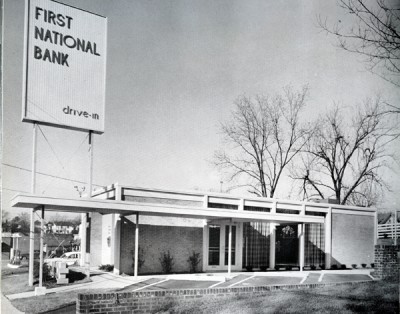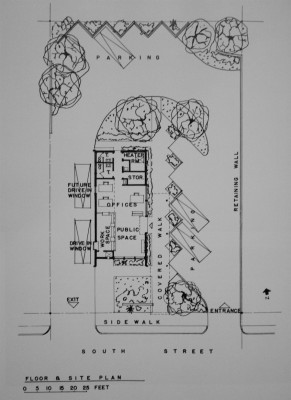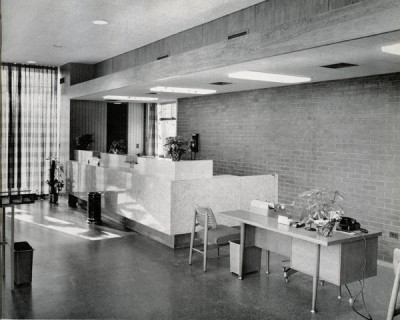From Drive-Through Pioneer to House of Worship: First National Bank
Nestled between a stretch of convenience stores and empty lots on South Street lies an architectural gem built a half century ago that served as one of the first in the area to offer drive-through banking. Originally home of First National Bank, the structure now serves as a house of worship for The Prayer of Deliverance COGIC (Church of God in Christ).
Much of the fenestration and landscaping elements have long since been removed or altered, but the building still stands proudly today in a long neglected corridor just slightly removed from the downtown revival taking place to the East. As the now absent sign in the first photograph shows, it was a “Drive-In” bank – a concept that was just beginning to emerge in the mid 1950s and early 1960s.
Although forward-thinking and planned at the height of the post-WWII era dominated by the automobile, attention and thought were given to the pedestrian and to the outdoor area around the structure. The plan above shows an equal balance of natural plant life and asphalt. Even though much of the original landscaping is now gone, the zig-zag masonry wall defining the parking area at the rear of the building still encloses a planting of small trees and shrubbery.
An advertisement for a banking supply company in the early 1950s stated:
“Auto Banking is here to stay by popular acclaim! Its convenience attracts new business. It saves despositors’ time as well as your own. It saves lobby and workspace. It shortens window lines.”*
While this claim may have been a bit dramatized, it did highlight the significant shift in the way Americans came to perceive the act of interacting with their local bank. This First National Bank was one of Raleigh’s pioneers in the move away from traditional classicist construction that focused on the walk-up counter as the sole method of banking.
The First National Bank building was designed by Carter Williams a few years before he began planning the BB&T branch that was erected in 1962 on the corner of Oberlin Road and Hillsborough Street. It was at this time of suburban growth that regulations were changed which had previously restricted or limited the number of branches a bank could operate.
While the current use of this structure is far removed from the original intent, it still remains intact and serves the community; a testament to one of the area’s most distinguished and talented architects.
(Historic images courtesy of Lewis P. Watson Collection)
* “How to Get Auto Banking Business,” advertisement for Herring-Hall-Marvin Safe Co., 1950








 Sign up for the Newsletter
Sign up for the Newsletter
04/09/2009
I found a color postcard of the first image online recently. What was the name of the sporting goods store nearby? Thornes? I bought a rod and reel and bb gun there.
04/11/2009
This is a good post — I know of no one (other than GNR) who is documenting Raleigh’s lesser known surviving modernist buildings. The use of the “then and now” approach is particularly striking. Good job!
The FNB was an NCNB bank in the late ’60s. I remember driving my VW beetle past that zig-zag angled parking around to the drive-through. Don’t remember if the 2nd one was ever installed, though. Don’t remember if that elevated sign was still there then, either. At that time I was just wanting to cash my part-time-job paycheck so I could buy 30-cent gasoline for my car.
10/12/2009
Lived in the area all my life. I remember this place as a thriving bank. Didnt know it was one of the first drive thru banks. Love this website!